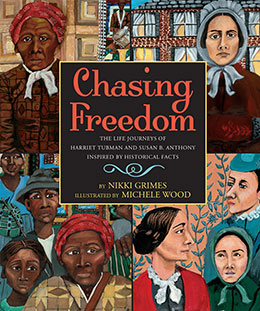
written by Nikki Grimes
illustrated by Michele Wood
Orchard Books, January 2015
Buy this book:
Chasing Freedom
The Life Journeys of Harriet Tubman and Susan B. Anthony, Inspired by Historical Facts
What if Harriet Tubman and Susan B. Anthony sat down over tea to reminisce about their extraordinary lives? What would they recall of their triumphs and struggles as they fought to achieve civil rights for African Americans and equal rights for women? And what other historical figures played parts in their stories? These questions led Coretta Scott King Award winner Nikki Grimes to create Chasing Freedom, an engaging work of historical fiction about two of the nineteenth century’s most powerful, and inspiring, American women.
With breathtaking illustrations by Coretta Scott King Award winner Michele Wood, Chasing Freedom richly imagines the experiences of Tubman and Anthony, set against the backdrop of the Underground Railroad, the Civil War, and the Women’s Suffrage Movement.
Additional back matter invites curious young readers to further explore this period in history — and the larger-than-life figures who lived it.
Awards and Recognition
- Amelia Bloomer Project
- Bank Street College Best Children’s Books of the Year 2016
- CCBC Choices 2016
- Chicago Public Library Best of the Best 2015
- NAACP Image Awards nominee
Resources
Reviews
Two iconic women recount their stories. In New York State in 1904, a suffragist convention is about to begin, and Susan B. Anthony is scheduled to introduce Harriet Tubman. But first the two women meet at Anthony’s home for tea and talk. Grimes artfully creates an afternoon of conversation and reminiscence in carefully constructed, fact-based vignettes that allow each to recount her life, accomplishments and continuing dreams. Each piece—there are 21—consists of both narration and dialogue that draw readers into the world of slavery, the Underground Railroad, the struggle for women’s rights, the fight for temperance and the dangers of public speaking on unpopular subjects. While not a dual biography, there is a plethora of information about both Tubman and Anthony as well as their times. Intended for reading aloud, the text can be an excellent supplement to 19th-century American studies. Wood’s full-page portraits are stunning. The folk-style acrylic-and-oil paintings are vibrant, detailed and emotionally charged. American quilt patterns and African motifs add to the depth of artistry. A tremendous opportunity for children to understand what these women worked so hard to accomplish—one succeeding and one coming close. (capsule biographies, additional notes, bibliography, author’s note) (Kirkus Reviews, starred review)
History is often taught in bits and pieces, and students rarely get the notion that these bits and pieces are connected,” writes Coretta Scott King Award–winning author Grimes in her author’s note. Here, she and fellow Coretta Scott King–winning illustrator Wood imagine an afternoon tea conversation between suffragette Susan B. Anthony and Underground Railroad conductor Harriet Tubman, where the women take turns relating interconnected stories from their lives. Each spread, including a page of text and a full-page illustration, tells a single anecdote, including personal turning points in each woman’s life and major historical events, such as John Brown’s raid on Harpers Ferry. In keeping with both activists’ strong religious convictions, God and biblical references are invoked often, and Wood’s painterly illustrations feature patterns inspired by American patchwork quilts and traditional African motifs. Back matter includes short biographies, additional notes, a bibliography, and an author’s note. Textual voice and bold pictorial color are strong, and Anthony’s and Tubman’s goals maintain relevance at a time when gender and race issues continue to be newsworthy. Skirting the edges of fictionalized biography can be tricky. Although Anthony and Tubman did meet repeatedly, Grimes states that this extended conversation comes purely from her imagination. Younger readers, who may not realize this immediately, may need guidance distinguishing the historical facts from the fictionalized musings. Audiences willing to embrace the unusual concept, though, may view this as a vanguard piece in an engaging newform that mixes nonfiction with historical fiction. (School Library Journal, starred review)
This unusual picture book imagines a conversation that could have taken place if Susan B. Anthony had invited Harriet Tubman to tea in 1904. Each two-page spread introduces a new dialogue, stitching together their memories and their views on matters such as slavery, temperance, women’s rights, and John Brown’s fight for abolition. Susan describes the hostile reception to her 1861 speeches calling for the emancipation of slaves, while Harriet recalls her journey to South Carolina as “nurse, cook, and spy” with the all-black Massachusetts Fifty-Fourth Regiment. Even readers familiar with each woman individually may occasionally be surprised by what the two contemporaries had in common — Grimes notes that they met several times “at antislavery and women’s rights conventions.” While some knowledge of American history is valuable as a framework for their stories, the text conveys a good deal of information in an involving way, and the back matter is uncommonly helpful. Across from each page of text is a striking, iconic full-page portrait, painted in oils and acrylics and often incorporating patchwork-quilt designs. Ready-made for reading aloud in three voices (Anthony, Tubman, and a narrator), this handsome picture book offers an original take on these significant Americans and fresh insights into their times. (Booklist, starred review)
Chasing Freedom is another beautiful, richly detailed book, a work of historical fiction that imagines a friendship between Harriet Tubman and Susan B. Anthony. Both women spent their lives working to end slavery and secure equal rights for women.
Nikki Grimes’s choice of format is notable. The story unfolds in a series of one-page vignettes, each building upon the previous one, as the two women meet for tea one afternoon and look back on their lives and work. This structure allows Grimes to introduce readers to movement leaders of the day. We see Frederick Douglass (who helped Tubman hide slaves in his home), John Brown (who told Tubman of his plan to raid Harpers Ferry) and Elizabeth Cady Stanton (who founded women’s groups with Anthony) (The New York Times)
Grimes (Words with Wings) creates an absorbing fictional conversation, based on historical incidents and documented quotations, between two indefatigable 19th-century crusaders for equal rights. The author imagines Tubman paying a visit to Anthony’s home on the day of the 1904 convention of the New York State Suffrage Association in Rochester, N.Y., where Anthony introduced Tubman as guest speaker. As the two women trade stories about their callings, accomplishments, and aspirations, Grimes adeptly reveals their shared philosophies, faiths, passion, and courage. The women’s distinct personalities also surface, as do Tubman’s storytelling talents and Anthony’s oratory skills. Inspired by American patchwork quilts and African motifs, Wood’s (Going Back Home) primitive acrylic and oil paintings incorporate handsome geometric and floral patterns, but it’s her piercing portraits of these women that stand out most, accentuating their compassion and resolve. Back matter provides relevant historical notes and brief biographies of Tubman, Anthony, and other like-minded contemporaries mentioned in their conversation, including John Brown, Frederick Douglass, and Elizabeth Cady Stanton. (Publishers Weekly)
Poet and author Nikki Grimes (Words with Wings) and artist Michele Wood (I See the Rhythm) together present two fascinating figures from history, as if they were engaged in conversation: Susan B. Anthony and Harriet Tubman.
The historical framework is factual. In 1904 at the 28th annual convention of the New York State Suffrage Association, in Rochester, Anthony introduced the famous conductor on the Underground Railroad, who was a guest speaker. Grimes then imagines a conversation between them in Anthony’s home, prior to the convention. Each page number appears against what resembles a quilt square. Woods’s acrylic and oil paintings carry this theme throughout the book. As Susan takes Harriet’s coat, a vine of leaves threads through the patterns of Susan’s gray gown, and diamond motifs dominate Harriet’s dress in chocolate brown. This palette connects the pair throughout the book. Harriet’s warm rust-colored turban becomes an identifying detail in the images that chart her journey on subsequent pages. Grimes covers a lot of ground, touching on the Temperance, Abolitionist and Women’s Suffrage movements, the Quakers’ involvement in them, and Tubman’s many trips to rescue her own family, then others from captivity. Grimes’s conversational tone makes accessible an abundance of information. Some may wish for attribution of sources from which she based her quotes, but four meaty pages of sources will point them to further reading.
Readers may be surprised to learn how closely Frederick Douglass worked with the two women, as well as John Brown and others. An eye-opening, aesthetically pleasing account of two extraordinary women. (Jennifer M. Brown, Shelf Awareness)


